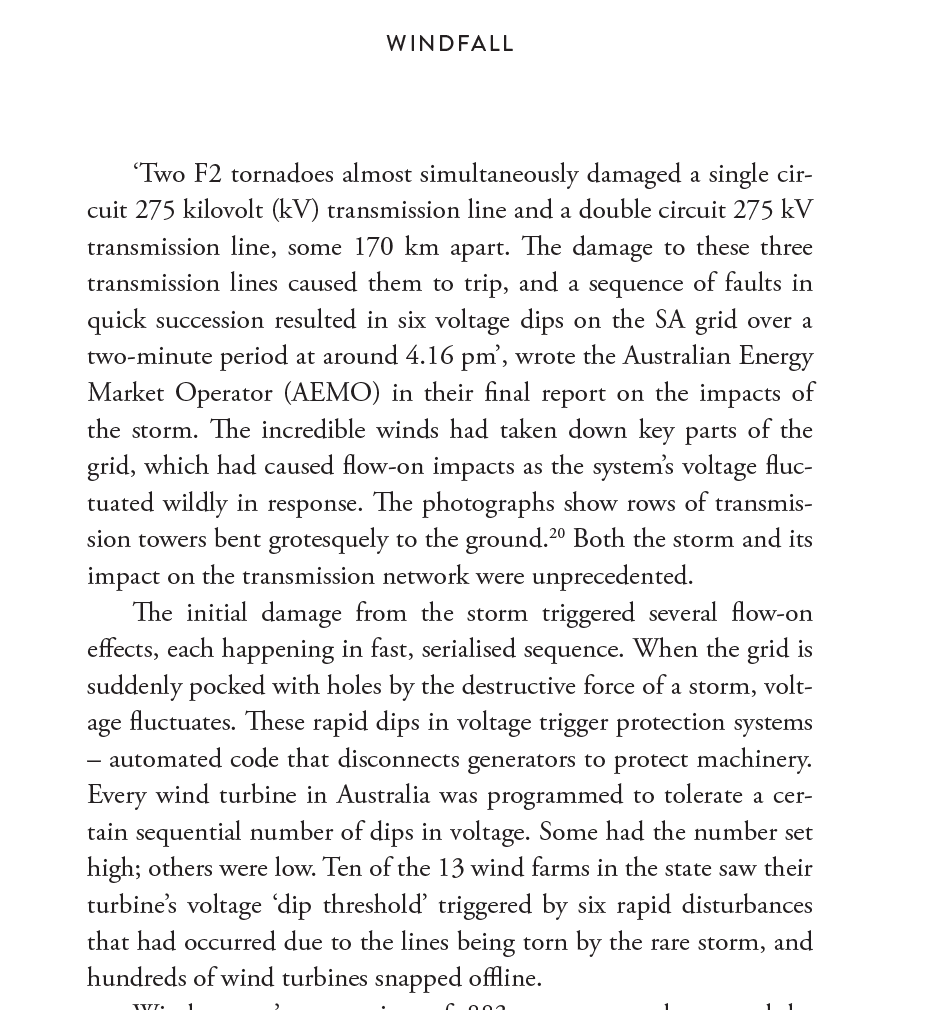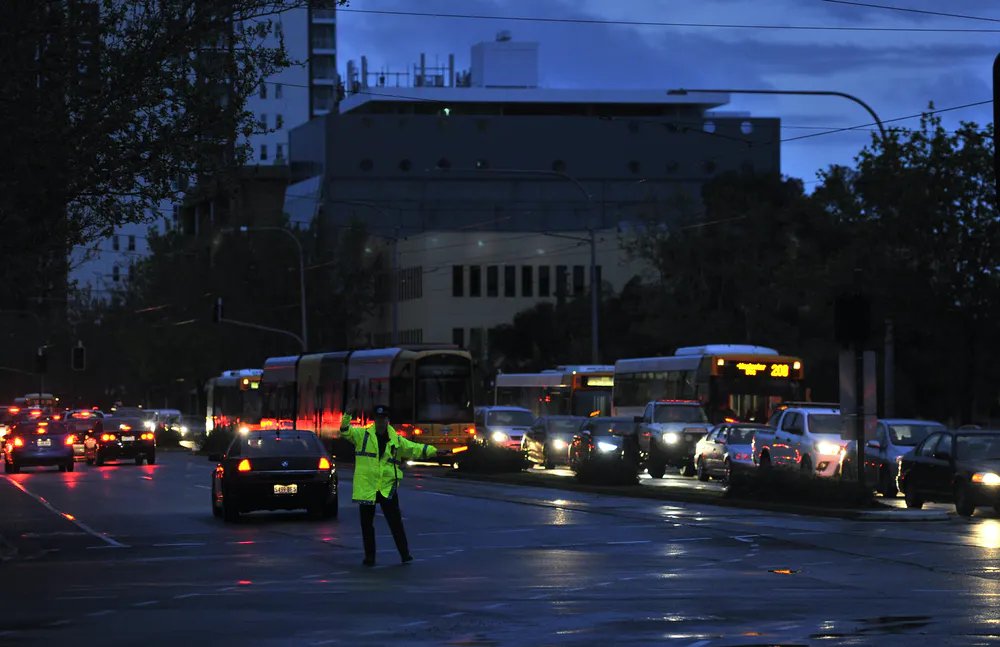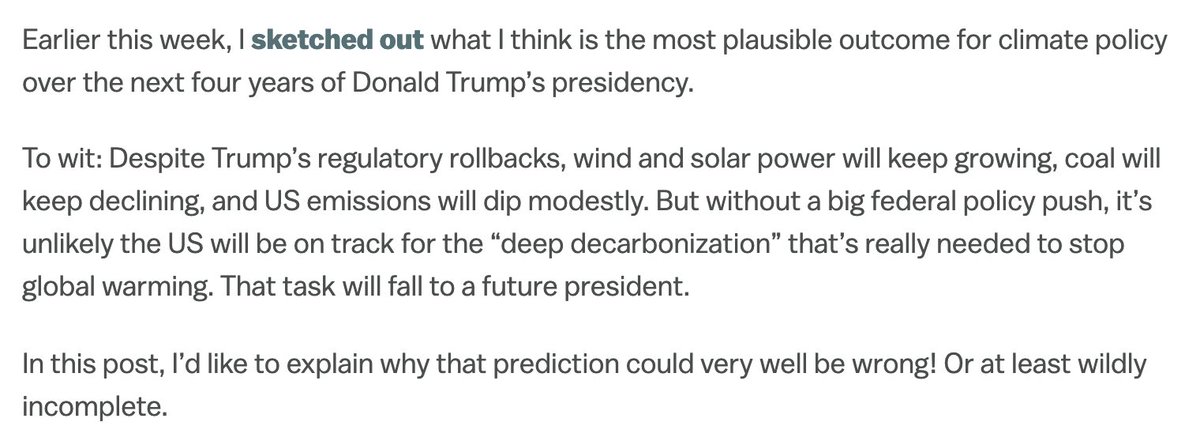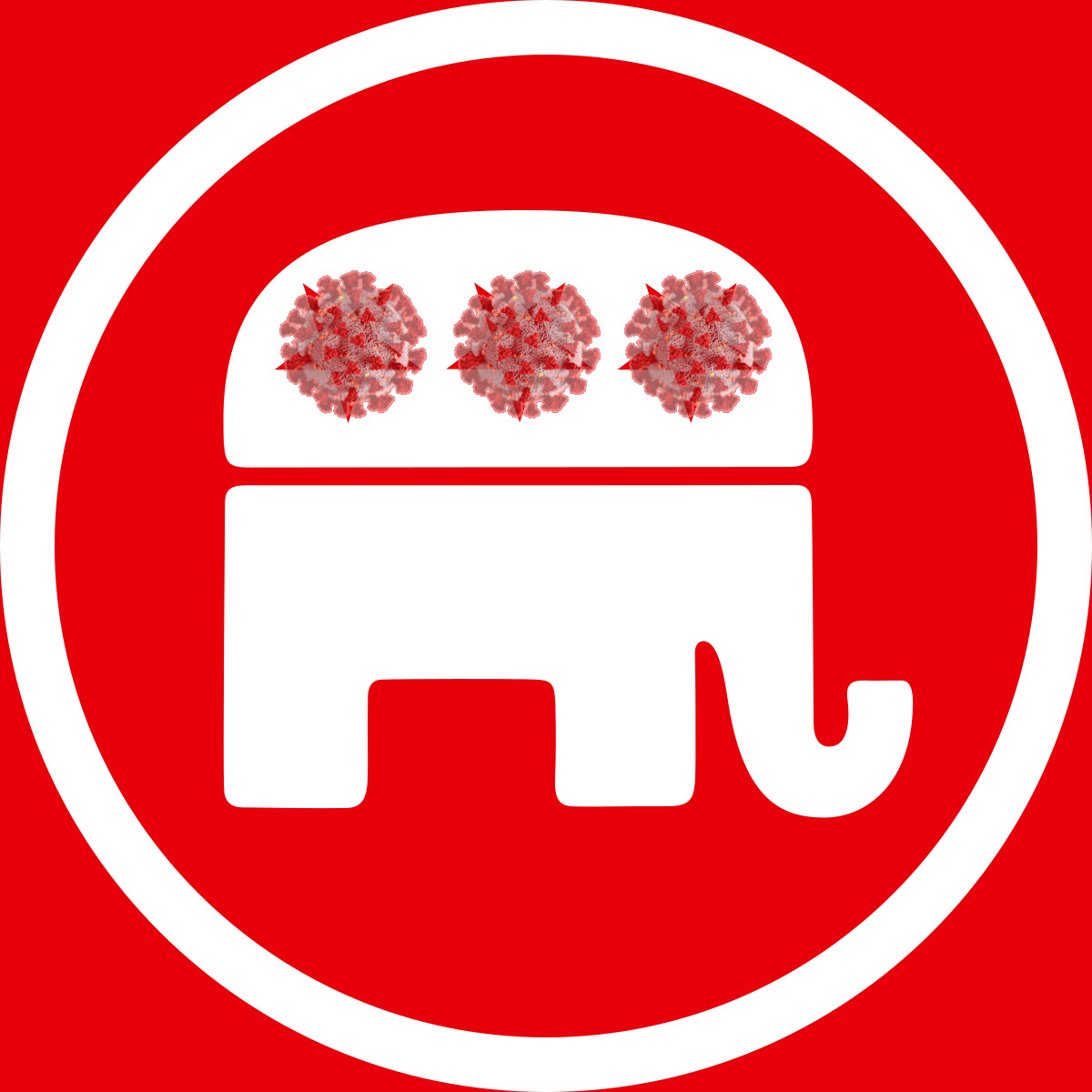
It's #FigureFriday, so let's chat about my favorite subject: color palettes 🎨 for climate science visualization! (1/12)





More from Climate change
I don't have time to make this detailed, but here's a little thread about the world's first major politically-charged blackout that was blamed on renewables, in South Australia, in 2016............
On September 28, 2016, an unprecedented tropical storm progressed rapidly across South Australia. Truly - this thing was unusual. The sky folded in on itself. It tore towns to bits.

Australia's @climatecouncil pointed out that the storm was so unusual at least partly due to the influence of climate change, and that this is due to get worse.
https://t.co/76ekkfJpR8

I'm going to use brief snippets from my book to fill this out! The storm's primary impact on the grid was the destruction of several major transmission lines. When I say destruction - I mean they snapped like twigs.

Here's what happened in the following seconds:
- A voltage spike from the line falls
- Wind turbines automatically shut off due to software settings that trigger shutdown during a spike
- The interconnector to Vic tried to compensate, failed and died
- All of SA blacked out

On September 28, 2016, an unprecedented tropical storm progressed rapidly across South Australia. Truly - this thing was unusual. The sky folded in on itself. It tore towns to bits.

Australia's @climatecouncil pointed out that the storm was so unusual at least partly due to the influence of climate change, and that this is due to get worse.
https://t.co/76ekkfJpR8

I'm going to use brief snippets from my book to fill this out! The storm's primary impact on the grid was the destruction of several major transmission lines. When I say destruction - I mean they snapped like twigs.

Here's what happened in the following seconds:
- A voltage spike from the line falls
- Wind turbines automatically shut off due to software settings that trigger shutdown during a spike
- The interconnector to Vic tried to compensate, failed and died
- All of SA blacked out

@smarzeli @ianrowley677 @chimera414 @BrknMan @ancistroneura @sueytonius @swcrisis @eloarefab @BailFund_Brawl @IngersolRobert @OscarsWild1 @RuleByLogic @KCTaz @Kenneth72712993 @alshalloway @ClimatePatriot @joetheatheistp @insane_voice @TheDisproof @Ceist8 @BradPKeyes @Fauntleroy1934 @DawnTJ90 @Jamz129 @JsharkJill @Tangomitteckel @joedieseldodge @BadgersNo @fknsavages27 @SimonPearson961 @JoeTheAtheist @CMorrisonEsq @maya_phd @CymaticWave @Schtickery @ClimateDepot @stevenmosher @Willard1951 @Tokyo_Tom @jc_Craze @DanCady @PolAnimalAus @ZombiePiano @SimonMaxfield8 @CrangusShish @Gladfly1 @AtomsksSanakan @leonardjcohen @FrankWi74044551 [1/14] It is very sad that @NatGeo is now publishing such disinformation. The article is lies.
The Earth is greening, thanks to elevated CO2 -- especially in arid
@ianrowley677 @chimera414 @BrknMan @ancistroneura @sueytonius @swcrisis @eloarefab @BailFund_Brawl @IngersolRobert @OscarsWild1 @RuleByLogic @KCTaz @Kenneth72712993 @alshalloway @ClimatePatriot @joetheatheistp @insane_voice @TheDisproof @Ceist8 @BradPKeyes @Fauntleroy1934 @DawnTJ90 @Jamz129 @JsharkJill @Tangomitteckel @joedieseldodge @BadgersNo @fknsavages27 @SimonPearson961 @JoeTheAtheist @CMorrisonEsq @maya_phd @CymaticWave @Schtickery @ClimateDepot @stevenmosher @Willard1951 @Tokyo_Tom @jc_Craze @DanCady @PolAnimalAus @ZombiePiano @SimonMaxfield8 @CrangusShish @Gladfly1 @AtomsksSanakan @leonardjcohen @FrankWi74044551 @NatGeo [2/14] NASA measures it, from
@ianrowley677 @chimera414 @BrknMan @ancistroneura @sueytonius @swcrisis @eloarefab @BailFund_Brawl @IngersolRobert @OscarsWild1 @RuleByLogic @KCTaz @Kenneth72712993 @alshalloway @ClimatePatriot @joetheatheistp @insane_voice @TheDisproof @Ceist8 @BradPKeyes @Fauntleroy1934 @DawnTJ90 @Jamz129 @JsharkJill @Tangomitteckel @joedieseldodge @BadgersNo @fknsavages27 @SimonPearson961 @JoeTheAtheist @CMorrisonEsq @maya_phd @CymaticWave @Schtickery @ClimateDepot @stevenmosher @Willard1951 @Tokyo_Tom @jc_Craze @DanCady @PolAnimalAus @ZombiePiano @SimonMaxfield8 @CrangusShish @Gladfly1 @AtomsksSanakan @leonardjcohen @FrankWi74044551 [3/14] @NatGeo used to be better. In 2009 they reported, "Vast swaths of North Africa are getting noticeably lusher due to warming temperatures, new satellite images show, suggesting a possible boon for people living in the driest part of the
@ianrowley677 @chimera414 @BrknMan @ancistroneura @sueytonius @swcrisis @eloarefab @BailFund_Brawl @IngersolRobert @OscarsWild1 @RuleByLogic @KCTaz @Kenneth72712993 @alshalloway @ClimatePatriot @joetheatheistp @insane_voice @TheDisproof @Ceist8 @BradPKeyes @Fauntleroy1934 @DawnTJ90 @Jamz129 @JsharkJill @Tangomitteckel @joedieseldodge @BadgersNo @fknsavages27 @SimonPearson961 @JoeTheAtheist @CMorrisonEsq @maya_phd @CymaticWave @Schtickery @ClimateDepot @stevenmosher @Willard1951 @Tokyo_Tom @jc_Craze @DanCady @PolAnimalAus @ZombiePiano @SimonMaxfield8 @CrangusShish @Gladfly1 @AtomsksSanakan @leonardjcohen @FrankWi74044551 [4/14] @NewScientist reported the "remarkable environmental turnaround," including a “quite spectacular regeneration of vegetation,” and "a 70 per cent increase in yields of local cereals such as sorghum and millet in one province in recent
@ianrowley677 @chimera414 @BrknMan @ancistroneura @sueytonius @swcrisis @eloarefab @BailFund_Brawl @IngersolRobert @OscarsWild1 @RuleByLogic @KCTaz @Kenneth72712993 @alshalloway @ClimatePatriot @joetheatheistp @insane_voice @TheDisproof @Ceist8 @BradPKeyes @Fauntleroy1934 @DawnTJ90 @Jamz129 @JsharkJill @Tangomitteckel @joedieseldodge @BadgersNo @fknsavages27 @SimonPearson961 @JoeTheAtheist @CMorrisonEsq @maya_phd @CymaticWave @Schtickery @ClimateDepot @stevenmosher @Willard1951 @Tokyo_Tom @jc_Craze @DanCady @PolAnimalAus @ZombiePiano @SimonMaxfield8 @CrangusShish @Gladfly1 @AtomsksSanakan @leonardjcohen @FrankWi74044551 @newscientist [5/14] Note that sorghum & millet are C4 plants. It was once thought that, unlike C3 plants, C4 plants would benefit little from rising CO2 levels. But C4 crops are favored for their drought-hardiness, &eCO2 is especially beneficial under dry
The Earth is greening, thanks to elevated CO2 -- especially in arid
@ianrowley677 @chimera414 @BrknMan @ancistroneura @sueytonius @swcrisis @eloarefab @BailFund_Brawl @IngersolRobert @OscarsWild1 @RuleByLogic @KCTaz @Kenneth72712993 @alshalloway @ClimatePatriot @joetheatheistp @insane_voice @TheDisproof @Ceist8 @BradPKeyes @Fauntleroy1934 @DawnTJ90 @Jamz129 @JsharkJill @Tangomitteckel @joedieseldodge @BadgersNo @fknsavages27 @SimonPearson961 @JoeTheAtheist @CMorrisonEsq @maya_phd @CymaticWave @Schtickery @ClimateDepot @stevenmosher @Willard1951 @Tokyo_Tom @jc_Craze @DanCady @PolAnimalAus @ZombiePiano @SimonMaxfield8 @CrangusShish @Gladfly1 @AtomsksSanakan @leonardjcohen @FrankWi74044551 @NatGeo [2/14] NASA measures it, from
@ianrowley677 @chimera414 @BrknMan @ancistroneura @sueytonius @swcrisis @eloarefab @BailFund_Brawl @IngersolRobert @OscarsWild1 @RuleByLogic @KCTaz @Kenneth72712993 @alshalloway @ClimatePatriot @joetheatheistp @insane_voice @TheDisproof @Ceist8 @BradPKeyes @Fauntleroy1934 @DawnTJ90 @Jamz129 @JsharkJill @Tangomitteckel @joedieseldodge @BadgersNo @fknsavages27 @SimonPearson961 @JoeTheAtheist @CMorrisonEsq @maya_phd @CymaticWave @Schtickery @ClimateDepot @stevenmosher @Willard1951 @Tokyo_Tom @jc_Craze @DanCady @PolAnimalAus @ZombiePiano @SimonMaxfield8 @CrangusShish @Gladfly1 @AtomsksSanakan @leonardjcohen @FrankWi74044551 [3/14] @NatGeo used to be better. In 2009 they reported, "Vast swaths of North Africa are getting noticeably lusher due to warming temperatures, new satellite images show, suggesting a possible boon for people living in the driest part of the
@ianrowley677 @chimera414 @BrknMan @ancistroneura @sueytonius @swcrisis @eloarefab @BailFund_Brawl @IngersolRobert @OscarsWild1 @RuleByLogic @KCTaz @Kenneth72712993 @alshalloway @ClimatePatriot @joetheatheistp @insane_voice @TheDisproof @Ceist8 @BradPKeyes @Fauntleroy1934 @DawnTJ90 @Jamz129 @JsharkJill @Tangomitteckel @joedieseldodge @BadgersNo @fknsavages27 @SimonPearson961 @JoeTheAtheist @CMorrisonEsq @maya_phd @CymaticWave @Schtickery @ClimateDepot @stevenmosher @Willard1951 @Tokyo_Tom @jc_Craze @DanCady @PolAnimalAus @ZombiePiano @SimonMaxfield8 @CrangusShish @Gladfly1 @AtomsksSanakan @leonardjcohen @FrankWi74044551 [4/14] @NewScientist reported the "remarkable environmental turnaround," including a “quite spectacular regeneration of vegetation,” and "a 70 per cent increase in yields of local cereals such as sorghum and millet in one province in recent
@ianrowley677 @chimera414 @BrknMan @ancistroneura @sueytonius @swcrisis @eloarefab @BailFund_Brawl @IngersolRobert @OscarsWild1 @RuleByLogic @KCTaz @Kenneth72712993 @alshalloway @ClimatePatriot @joetheatheistp @insane_voice @TheDisproof @Ceist8 @BradPKeyes @Fauntleroy1934 @DawnTJ90 @Jamz129 @JsharkJill @Tangomitteckel @joedieseldodge @BadgersNo @fknsavages27 @SimonPearson961 @JoeTheAtheist @CMorrisonEsq @maya_phd @CymaticWave @Schtickery @ClimateDepot @stevenmosher @Willard1951 @Tokyo_Tom @jc_Craze @DanCady @PolAnimalAus @ZombiePiano @SimonMaxfield8 @CrangusShish @Gladfly1 @AtomsksSanakan @leonardjcohen @FrankWi74044551 @newscientist [5/14] Note that sorghum & millet are C4 plants. It was once thought that, unlike C3 plants, C4 plants would benefit little from rising CO2 levels. But C4 crops are favored for their drought-hardiness, &eCO2 is especially beneficial under dry
Rising CO2 levels mitigate drought impacts. Elevated CO2 (eCO2) helps plants use water more efficiently, by improving CO2 stomatal conductance relative to transpiration. It's especially helpful in arid regions & during drought. Here's a paper about corn:https://t.co/lZ0wL4Gnvn
— Dave Burton \u274c (@ncdave4life) August 19, 2020
It was a dark and stormy night...
(I’ve always wanted to tweet that) But seriously, there was a tropical storm when a group of people gathered in the woods.
If they were white, we’d call them “founding fathers” but they were slaves who were about to change the world
A thread
Voudou priestess Cecile Fatiman danced with a knife. Then she split a pig and everyone drank the pig’s blood from a wooden bowl while enslaved priest Cutty Boukman prayed:
“The god who created the earth; who created the sun that gives us light. The god who holds up the ocean;
who makes the thunder roar. Our god who has ears to hear. You who are hidden in the clouds, who watch us from where you are. You see all that the white has made us suffer. The white man’s god asks him to commit crimes. But the god within us wants to do good...
It’s He who will direct our arms and bring us the victory. It’s He who will assist us. We all should throw away the image of the white men’s god who is so pitiless. Listen to the voice for liberty that speaks in all our hearts.”
Then , the meeting adjourned & everyone went home.
A week later, on Aug. 21 1791, it began.
In one week, 1800 plantations on the Island of St. Domingue would be burned to the ground and 1,000 white enslavers would be dead.
The shit had finally hit the fan.
(I’ve always wanted to tweet that) But seriously, there was a tropical storm when a group of people gathered in the woods.
If they were white, we’d call them “founding fathers” but they were slaves who were about to change the world
A thread
Holup. I ain't learned about this in school. What was this??
— Drunk Tweets, Inc - Mask it or Casket (@DrunkTweetsInc) January 1, 2021
Voudou priestess Cecile Fatiman danced with a knife. Then she split a pig and everyone drank the pig’s blood from a wooden bowl while enslaved priest Cutty Boukman prayed:
“The god who created the earth; who created the sun that gives us light. The god who holds up the ocean;
who makes the thunder roar. Our god who has ears to hear. You who are hidden in the clouds, who watch us from where you are. You see all that the white has made us suffer. The white man’s god asks him to commit crimes. But the god within us wants to do good...
It’s He who will direct our arms and bring us the victory. It’s He who will assist us. We all should throw away the image of the white men’s god who is so pitiless. Listen to the voice for liberty that speaks in all our hearts.”
Then , the meeting adjourned & everyone went home.
A week later, on Aug. 21 1791, it began.
In one week, 1800 plantations on the Island of St. Domingue would be burned to the ground and 1,000 white enslavers would be dead.
The shit had finally hit the fan.
You May Also Like
Oh my Goodness!!!
I might have a panic attack due to excitement!!
Read this thread to the end...I just had an epiphany and my mind is blown. Actually, more than blown. More like OBLITERATED! This is the thing! This is the thing that will blow the entire thing out of the water!
Has this man been concealing his true identity?
Is this man a supposed 'dead' Seal Team Six soldier?
Witness protection to be kept safe until the right moment when all will be revealed?!
Who ELSE is alive that may have faked their death/gone into witness protection?

Were "golden tickets" inside the envelopes??

Are these "golden tickets" going to lead to their ultimate undoing?
Review crumbs on the board re: 'gold'.

#SEALTeam6 Trump re-tweeted this.

I might have a panic attack due to excitement!!
Read this thread to the end...I just had an epiphany and my mind is blown. Actually, more than blown. More like OBLITERATED! This is the thing! This is the thing that will blow the entire thing out of the water!
Tik Tok pic.twitter.com/8X3oMxvncP
— Scotty Mar10 (@Allenma15086871) December 29, 2020
Has this man been concealing his true identity?
Is this man a supposed 'dead' Seal Team Six soldier?
Witness protection to be kept safe until the right moment when all will be revealed?!
Who ELSE is alive that may have faked their death/gone into witness protection?

Were "golden tickets" inside the envelopes??

Are these "golden tickets" going to lead to their ultimate undoing?
Review crumbs on the board re: 'gold'.

#SEALTeam6 Trump re-tweeted this.













